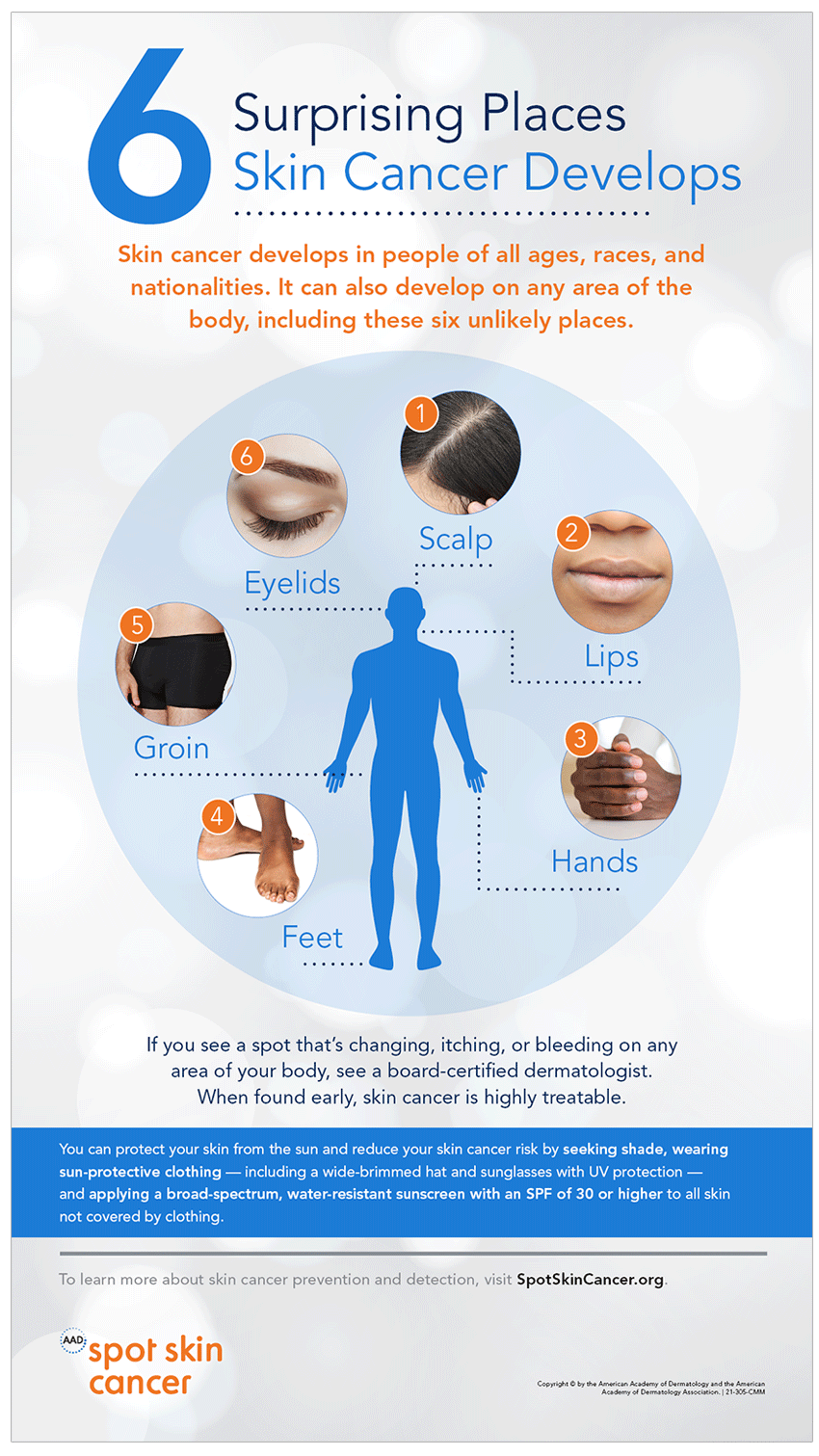Skin cancer: Everyone's at risk
Don't let skin cancer sneak up on you
Do you know how to spot skin cancer? In this video, the American Academy of Dermatology used an ultraviolet camera to show people the sun damage hidden underneath their skin. While you can’t see all the sun damage on your skin, it’s important to check the spots you can see – before it’s too late.
Can you spot skin cancer?
Anyone can get skin cancer, regardless of skin color. It is estimated that one in five Americans will develop skin cancer in their lifetime. When caught early, skin cancer is highly treatable.
Everyone is at risk for skin cancer. How much do you know about skin cancer?
Basal cell carcinoma and squamous cell carcinoma
These are the most common forms of skin cancer, and are collectively referred to as non-melanoma skin cancers.
These arise within the top layer of the skin and can appear on any sun-exposed area of the body, but are most frequently found on the face, ears, bald scalp, and neck.
Basal cell carcinoma frequently appears as a pearly bump, whereas squamous cell carcinoma often looks like a rough, red, scaly area, or an ulcerated bump that bleeds.
Although non-melanoma skin cancer spreads slowly, if left untreated, it can lead to disfigurement.
Researchers estimate that 5.4 million cases of non-melanoma skin cancer, including basal cell carcinoma and squamous cell carcinoma, were diagnosed in 3.3 million people in the United States in 2012.
See a board-certified dermatologist if you spot anything changing, itching, or bleeding on your skin.
When caught early and treated properly, skin cancer is highly curable.
Melanoma
This is the most deadly form of skin cancer.
Nearly 20 Americans die from melanoma every day.
Melanoma may suddenly appear without warning, but can also develop from or near an existing mole.
It can occur anywhere on the body, but is most common on the upper back, torso, lower legs, head, and neck.
Melanoma frequently spreads to lymph nodes and most internal organs, making early detection and treatment essential.
See a board-certified dermatologist if you spot anything changing, itching, or bleeding on your skin.
New, rapidly growing moles, or moles that itch, bleed, or change color are often early warning signs of melanoma and should be examined by a dermatologist.
If detected early and treated properly, melanoma is highly treatable.
To help you spot skin cancer early, when it’s most treatable, the American Academy of Dermatology recommends that everyone learn the ABCDEs of melanoma:
A is for Asymmetry: One half of the mole does not match the other half.
B is for Border irregularity: The edges are ragged, notched, or blurred.
C is for Color that varies from one area to another.
D is for Diameter: While melanomas are usually greater than 6mm (the size of a pencil eraser) when diagnosed, they can be smaller.
E is for Evolving: A mole or skin lesion that looks different from the rest or is changing in size, shape, or color.
Infographic: 6 surprising places skin cancer develops
Skin cancer develops in people of all ages, races, and nationalities. It can also develop on any area of the body, including these six unlikely places. This infographic shows six places you might not think to check for skin cancer.

Related AAD resources
Last updated: 11/4/24
 Atopic dermatitis: More FDA-approved treatments
Atopic dermatitis: More FDA-approved treatments
 Biosimilars: 14 FAQs
Biosimilars: 14 FAQs
 How to trim your nails
How to trim your nails
 Relieve uncontrollably itchy skin
Relieve uncontrollably itchy skin
 Fade dark spots
Fade dark spots
 Untreatable razor bumps or acne?
Untreatable razor bumps or acne?
 Tattoo removal
Tattoo removal
 Scar treatment
Scar treatment
 Free materials to help raise skin cancer awareness
Free materials to help raise skin cancer awareness
 Dermatologist-approved lesson plans, activities you can use
Dermatologist-approved lesson plans, activities you can use
 Find a Dermatologist
Find a Dermatologist
 What is a dermatologist?
What is a dermatologist?